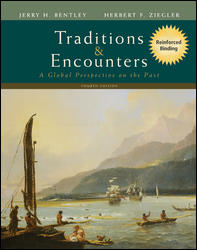1 A) She unwittingly infected many of her people with smallpox. B) She betrayed the secret entrance to Tenochtitlan. C) She bore Cortés a child, who would bring unity between both peoples. D) She could speak several native languages and served as an interpreter. E) She was the first Catholic convert. 2 A) Aztecs. B) Incas. C) Iroquois. D) Maya. E) Tainos. 3 A) the encomienda system. B) the hacienda. C) slavery. D) indentured servitude. E) the repartimiento system. 4 A) superior Spanish technology, especially swords, muskets, cannons, and horses. B) a devastating smallpox epidemic. C) the inadequate defenses of Tenochtitlan. D) the resentment of many indigenous peoples to Aztec rule. E) All of the answers are correct. 5 A) the Catholic church. B) the audiencias. C) the colonial legislature. D) the Spanish crown. E) the colonial militias. 6 A) Portuguese mariners were first to explore the Amazon basin. B) The Treaty of Tordesillas, designed to divide the Atlantic between Spain and Portugal, unintentionally granted Brazil to Portugal. C) Initially, the Spanish had no interest in South America. D) The Indians of Brazil successfully resisted Spanish invaders. E) None of the answers are correct. 7 A) of the large, densely populated Indian communities that dominated the coast. B) the first English settlements did not prepare sufficient food crops. C) the colonies did not produce commodities that Europeans were eager to buy. D) the English government did not support or protect the colonies. E) All of the answers are correct. 8 A) the Spanish crown was less actively involved in the government of their colonies. B) English governors were elected directly by the colonists, while Spanish viceroys were appointed by the crown. C) Spanish colonies had powerful local assemblies, while the English did not. D) English colonies were often financed by private investors, who retained control over colonial affairs. E) the Church played a greater role in the administration of Spanish colonies. 9 A) The settlers negotiated treaties. B) Because the Indians were not Christian, they had no right to the land. C) Because the Indians were hunters and gatherers rather than farmers, their claims to the land were not considered valid. D) The settlers established squatters' rights on unoccupied lands. E) By defeating the Indians in battle, the English and French claimed the land as a spoil of war. 10 A) a person born in Spain who immigrated to the New World. B) a person of Spanish descent born in the New World. C) a person of mixed Spanish and Indian descent. D) a person of mixed African and Indian descent. E) a person of mixed Spanish and African descent. 11 A) they were born in the western hemisphere and not the eastern hemisphere. B) their mothers were part Indian. C) they had no land and were economically dependent. D) they had not yet been baptized in the Catholic church. E) they were indentured servants while peninsulares were free. 12 A) minerals like silver and gold. B) sugar and rum. C) tobacco. D) furs. E) timber. 13 A) Mining increased the demand for labor, sparking the growth of an Indian middle class. B) Mineral ores from Mexico provided the raw materials for European manufacturing. C) The sale of slaves to the mines by the Portuguese resulted in the Portuguese spending their wealth throughout Europe and Africa. D) The Spanish quinto circulated throughout European and Asian markets. E) All of the answers are correct. 14 A) It was used by the Spanish at Potosi. B) It had been used by the Inca. C) It was a form of slavery in that workers were not paid. D) It led to high rates of death among workers. E) It affected a large portion of the indigenous population. 15 A) indentured servitude. B) slavery. C) the mita system. D) the encomienda system. E) wage labor. 16 A) Sugar production was particularly hard on the environment. B) Sugarcane required extensive processing to turn it into a profitable export. C) African slaves were the only ones who knew how to grow sugarcane. D) Sugar was extremely profitable with very little investment. E) It was only possible to grow in Brazil, and it had an extremely short growing season. 17 A) intense competition and even warfare between indigenous peoples for European trade. B) intense competition between French, Dutch, and English fur traders. C) the decimation of the beaver population in North America. D) hostile relations between European traders and Native American trappers. E) the introduction of European manufactured goods to indigenous peoples. 18 A) returned disappointed to Europe. B) hoped to become wealthy plantation-owners. C) hoped to become active in the politics of the colonies. D) hoped to become independent artisans or planters. E) remained in debt for many years. 19 A) Mesoamerican and South American Indians found many similarities between their religions and Catholicism. B) North American Indians were more geographically scattered and so harder for missionaries to reach. C) Catholic missionaries in Spanish America were more tolerant of native cultures than were the Protestant missionaries in North America. D) Catholic rule in the New World was more generous and enlightened than the English or the French rule. E) None of the answers are correct. 20 A) the first explorers were driven away by hostile aborigines. B) the first explorers could not sail across the Great Barrier Reef. C) the land appeared too densely forested to settle easily. D) it was too far from European markets. E) All of the answers are correct.





